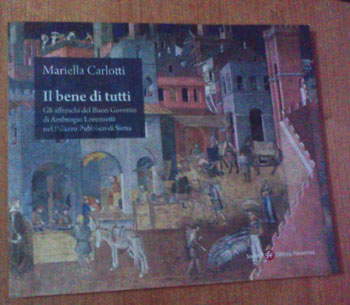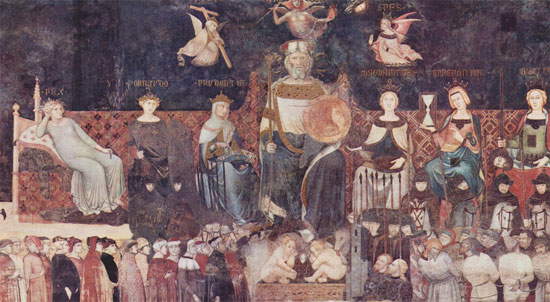An art history book that looks a lot like a civics book: after all, what is art history for if not to educate, as well as to excite and move minds? We could summarize in this way the interesting book The Good of All, written by Mariella Carlotti and published by Società Editrice Fiorentina. It is a book entirely dedicated to a single work of art: the frescoes of Good Government and Misrule by Ambrogio Lorenzetti that decorate the Sala dei Nove inside Siena’s Palazzo Pubblico.
 |
| Mariella Carlotti, The Good of All |
Mariella Carlotti offers us a nimble, no-frills book of just over one hundred pages, with beautiful illustrations in color</strong, and above all devoid of the rhetoric that is the main risk for those about to write a text on a work of dense political significance. A work that cannot be understood unless one immerses oneself in fourteenth-century Siena. We are, in particular, between 1338 and 1339. Siena is experiencing a fruitful artistic and cultural season: the Lorenzetti brothers are at the height of their careers, Simone Martini has recently left the city to move to Avignon, and alongside the greatest there is a whole host of minor artists, but capable of making Siena the main artistic center, along with Florence, of Italy at the time. Above all, Siena is a city that enjoys political stability and a period of lasting prosperity, which began in 1287, with the establishment of the Government of the Nine, a junta of nine citizens, drawn from the local bourgeoisie, who were able to kick-start what is regarded as the Golden Age of Siena’s history: a period of almost seventy years, from 1287 until 1355. It was under the Government of the Nine that the Palazzo Pubblico and the celebrated Piazza del Campo were built, but above all, it was with the Government of the Nine that the city was provided with a system of laws that, a novelty for the time, was translated into the vernacular (the language of administration was in fact Latin) and made available to all citizens who wished to read it. Moreover, those who governed Siena had to commit themselves to doing so with justice and fairness. With great modernity and civic-mindedness far ahead of its time, the 1309 Constituto required the rulers of Siena to hold in supreme consideration the beauty of the city, for the cause of delight and cheerfulness to strangers, and for the honor, prosperity, and increase of the city and its citizens. In short, beauty is seen as something that must have a public purpose, must teach.
Ambrogio Lorenzetti’s frescoes well fulfill the task of demonstrating, perhaps too schematically for the eyes of us contemporaries, but nonetheless effectively, what is the beauty that makes a city grow prosperously, and what, on the other hand, are the dangers and horrors of a city that has fallen into the hands of misrule: and that of Ambrogio Lorenzetti (and of the Government of the Nine that commissioned him to paint the frescoes) is a warning that is still valid today. Mariella Carlotti, after taking us through the history of Siena from its origins to the fourteenth century, and after dwelling for a whole chapter on the magistracy of the Nine, first tells us about the Sienese school, then introduces us to the figure of the great Ambrogio Lorenzetti, and finally tells us about his frescoes, not forgetting a few mentions of the palace that contains them.
 |
| The Good Government of Ambrogio Lorenzetti |
One of Mariella Carlotti’s main points of reference is Dante Alighieri, who is often called upon to give literal (and literary) voice to Ambrogio’s frescoes: but there is no ostentation, these are not superfluous references, because Dante guides us in understanding the scenes frescoed in the Sala dei Nove. And it is highly probable that Ambrose himself was well aware of Dante’s work, or at any rate mastered its concepts because, for example, if Dante declares that justice is an effect of heaven(O sweet star, quali e quante gemme / mi dimostraro che nostra giustizia / effetto sia del ciel che tu ingemme! Paradiso, XVIII, 115-117), in Ambrose’s fresco we see that the allegory of justice, characterized by the attribute of the scales with two angels, one rewarding the good and the other punishing the wicked, is aided by the allegory of divine wisdom, which supports the scales. Precisely indicating that justice comes from divine wisdom.
With constant cross-references between art and literature, The Good of All (and, by the way: no better title could have been chosen to indicate that we can all benefit from viewing these frescoes) deals with all the walls frescoed by Ambrose with individual chapters devoted (one to the Allegory of Good Government, one to the effects of Good Government on the city, a further one on the Allegory of Misrule and the effects of Misrule on the city) to reach the concluding chapter, entirely devoted to the splendid Crucifix by Lando di Pietro, which tells the singular story of a work made in the same year as Lorenzetti’s frescoes. I refer you to reading the book to understand why the story of this Crucifix ties in so well with the Buon Governo frescoes.
The book is therefore definitely recommended: an easy read, but one that offers a great deal of food for thought (I have suggested a few in this post, but it is but a small part of what can be gleaned from The Good of All), suitable for a wide audience, even those unacquainted with art history. Anyone can benefit from reading this book. Especially those who believe that beauty is a “cause of delight,” of “honor,” “prosperity,” and “increase” for all. This is, perhaps, the highest lesson Ambrogio Lorenzetti has given us with his frescoes.
The good of all. Ambrogio Lorenzetti’s frescoes of Good Government in the Palazzo Pubblico of Siena
By Mariella Carlotti
Società Editrice Fiorentina, 2010
105 pages
16
Warning: the translation into English of the original Italian article was created using automatic tools. We undertake to review all articles, but we do not guarantee the total absence of inaccuracies in the translation due to the program. You can find the original by clicking on the ITA button. If you find any mistake,please contact us.